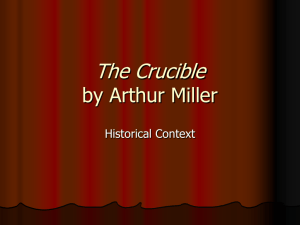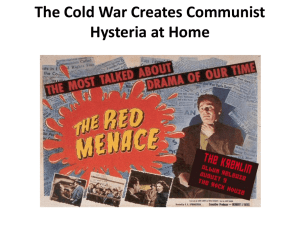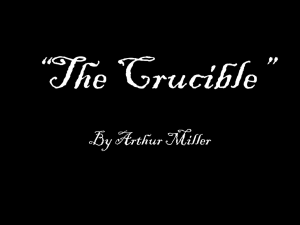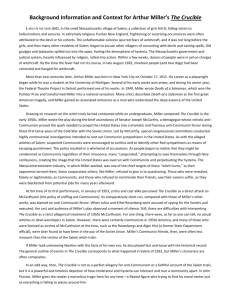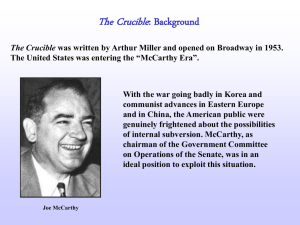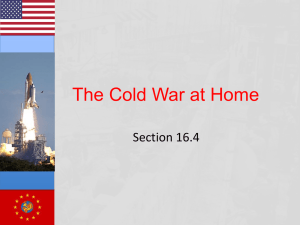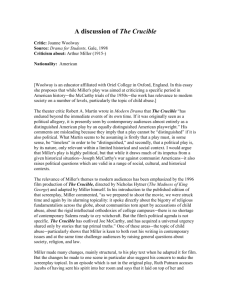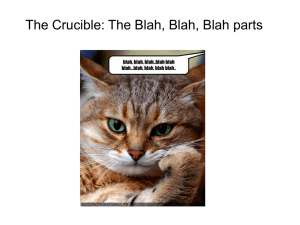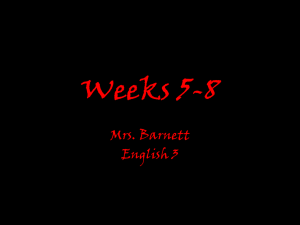McCarthyism:
advertisement
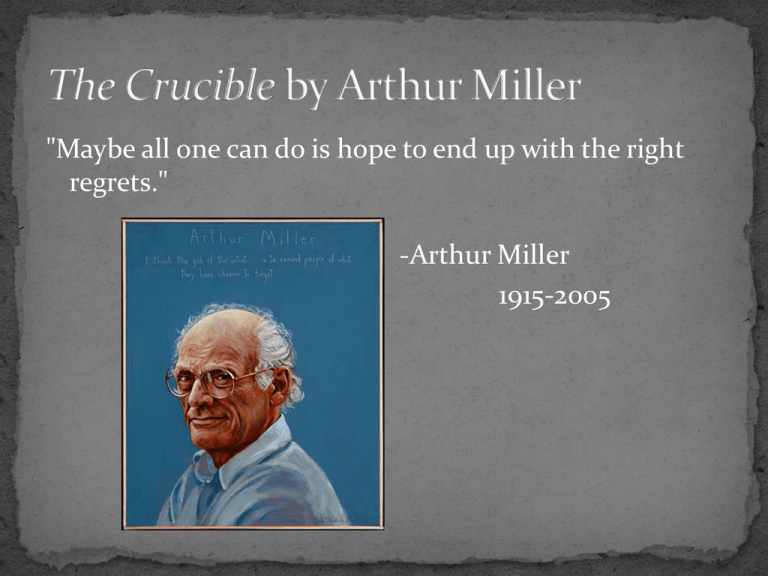
"Maybe all one can do is hope to end up with the right regrets." -Arthur Miller 1915-2005 Grew up during the Great Depression Wrote screenplays for Hollywood Won a Pulitzer in 1949 for Death of a Salesman. 1953- wrote The Crucible based on Salem Witch Trials. He wrote the play during the McCarthy hearings when his friends were being attacked for procommunist activities. •Attended The University of Michigan for Journalism but graduated with a degree in English • Wrote two short plays under the collective title of A View From The Bridge(1954); •Married Marilyn Monroe (1956), wrote screenplays (Misfits) with roles for his wife, and divorced her (1961); She dies 1962 •1965 – Miller was elected president of P.E.N, the international literary organization •Numerous problems with the House of Un-American Activities Committee for being a “romantic Marxist”; •After a nine year hiatus he returned with After the Fall – a seemingly autobiographical play about Marilyn Finishing the Picture – last play, depicted the making of Misfits. It is important to note that Miller used the events and names of those who were involved in the actual Salem Witch Trials… However, he made changes in order to create his story….. For example: Abigail Williams was 11 during the actual trials not 16 and did not have an affair with John Proctor. However she was involved in the accusations…. Arthur Miller & The Crucible: When The Crucible opened in January of 1953, audiences noted the similarities between the Salem Witch Trials and the HUAC investigations. In 1956 Miller was called to testify before the committee. He was later convicted of Contempt of Congress for refusing to name persons seen at meetings organized by socalled Communist sympathizers. Miller’s conviction was overturned in 1958. Before he sat before the committee, a congressman requested a signed Marilyn Monroe photograph, saying that the hearing would be dropped. Miller refused, just as he refused to give up any names. He stated, “I don’t believe a man has to become an informer in order to practice his profession freely in the United States.” “Witch hunt”refers to any search for a scapegoat who can be blamed for all the ills of society and whose removal will eliminate the problems. Miller’s play depicts Human Nature’s role when fear and hysteria take over…..this is a universal quality that transcends time. The Witch Hunt without Witches A term for the widespread accusations and investigations of suspected Communist activities in the U.S. during the 1950s. Fed by the quick invention of the Soviet Atomic Bomb. It was assumed spies must have helped them. Blamed the problems of the U.S. on the supposed secret presence of Communists in the government Senator Joseph R. McCarthy was a little-known junior senator from Wisconsin. He claimed to possess a list of 205 card-carrying Communists employed in the U.S. Department of State. “McCarthy's power to stir fears of creeping Communism was not entirely based on illusion, of course; the paranoid, real or pretended, always secretes its pearl around a grain of fact.” -Arthur Miller Loyalty boards investigated the federal workers under Truman’s command to search The senator created the UnAmerican Activities Committee (HUAC) HUAC- most widely known for its investigations of suspected Communist influence in the late 1940s and early 1950s. 1947, HUAC subpoenaed 41 witnesses for its hearings on Communist influence in Hollywood. Ten of them, mostly writers and directors, refused to answer questions at first, denounced the committee, and were held in contempt of Congress. These witnesses became known as the “Hollywood Ten” and were “blacklisted” from the industry for many years afterward. The Big Hollywood 10: 8 of 10 actors refused to appear in court and were sentenced to a year in prison The Waldorf statement: stated that 8 of the ten were to be fired The blacklist: Informally, if you were accused of communism you could not be hired McCarthyism is now used as a reference to “reckless public accusations of disloyalty to the U.S.” Friendly Witness: Testified and gave names of potential Communist sympathizers Unfriendly Witnesses: Either refused to testify at all or refused to give names. Innocent people’s careers ruined- three hundred and twenty artists were blacklisted (Among them were Arthur Miller and Charlie Chaplin.) Arthur Miller & The Crucible: Miller wrote The Crucible as an allegory for the unjust accusations of Joseph McCarthy. During McCarthyism, the United States was terrified of Communism's influence. Like the witches, communists were seen ingrained within every aspect of society. Miller was sent to jail for withholding information from the court, namely the names of those assumed to be communists. Many of Miller’s peers fearing the wrath of the court provided names of suspected communists in an attempt to save themselves. During both time periods (Salem and McCarthyism), the enemy did exist and people used fear to reach their own goals and fulfill hidden agendas. McCarthy’s influence finally faltered in 1954 when a famous CBS newsman, Edward R. Murrow, aired an investigative news report which revealed McCarthy as dishonest in his speeches and abusive in his interrogation of witnesses The public was finally made aware of how McCarthy was ruining the reputations of many individuals through false accusations of communism. In 1954, he made accusations against the US Army Resulted in a nationally televised Senate investigation Censured by Senate in 1954.


